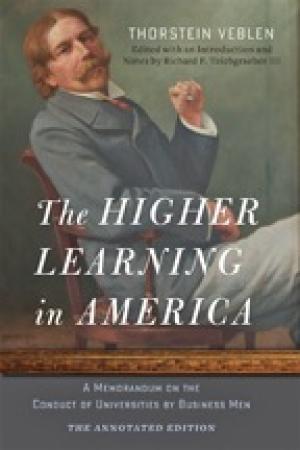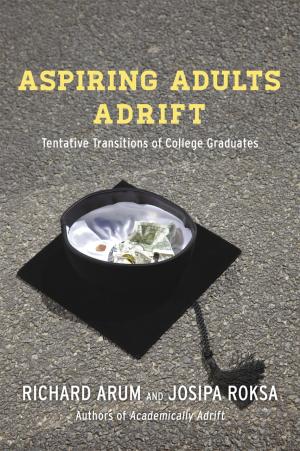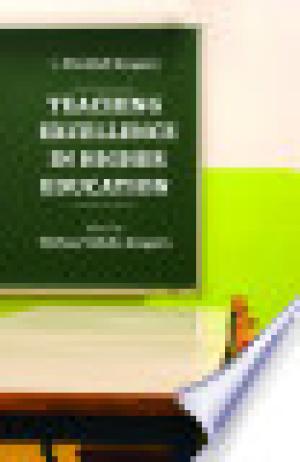Resources by Ronald R. Bernier

While often repeated, at least by scholars of the original 1918 document, it bears retelling here that the original subtitle of Thorstein Veblen’s The Higher Learning in America was “A Study of Total Depravity.” And while such language was sanitized for publication the author’s irritation with the “bootless meddling” of governing boards and the “skilled malpractice” of university presidents, was no less strident and prevalent throughout his text. The recently published, first-ever annotated edition of Veblen’s important – and, unfortunately, still timely – report put this reviewer in mind of much more recent such studies, and thus will be reviewed here in the context of these recent contributions to what Veblen called “the professors’ literature of protest” (for example, see Ginsberg [The Fall of the Faculty, Oxford University Press, 2011] and Menand [The Marketplace of Ideas, Norton, 2010]). Richard F. Teichgraeber’s excellent “Introduction,” as well as his editorial notes throughout, make this timeliness clear. Veblen retrospectively joins a host of prominent scholars who have engaged a broad institutional critique of higher education, and he was by no means the first to caution against the threat to the American university’s independence, by its uncritical adoption of the methods – and its serving the needs – of the business community. In this Veblen presages the pessimistic diagnosis of American undergraduate education offered in 1996 by the late Bill Readings in his much-quoted University in Ruins (Cambridge, Mass., Harvard University Press), in which the author excoriated the contemporary American “corporatized” university as a “ruined institution” hopelessly “enmeshed in consumerist ideology” (Veblen’s “salesmanlike proficiency”). Many have since echoed this sentiment, not least among them Harvard professor, James Engell, who in 1998 painted a similarly discouraging picture of the current state of affairs for undergraduate study, calling particular attention to higher education’s rush to fall in line with business and government calls for greater “relevance,” “application,” and “preparation for working life” outside the academy – all measured by metrics of cost, efficiency, and productivity. In an article entitled “The Market-Model University: Humanities in the Age of Money,” (Harvard Magazine) Engell cites persuasive evidence that economic pressures have negatively, if not irrevocably, impacted American collegiate education – for instance, declining enrollments in traditional liberal arts disciplines,with the corresponding reality for faculty equally gloomy: the lowest faculty salaries compared to colleagues in the pre-professional disciplines (full-throatedly denounced by Veblen), the most onerous teaching loads (“notoriously underpaid and so scantily filled as seriously to curtail their working capacity,” according to Veblen), and the least academically prepared and intellectually engaged students. Such a move toward “aggressive mediocrity,” with faculty “managed according to the principles of the consumer-driven marketplace,” as Veblen put it in 1918, has resulted, as essayist and critic William Deresiewicz would have it, in American higher education “slouching toward a glorified form of vocational training” (“Faulty Towers: The Crisis in Higher Education,” The Nation, 2011). “The liberal arts university,” argues Deresiewicz, “is becoming the corporate university, its center of gravity shifting to technical fields where scholarly expertise can be parlayed into lucrative business opportunities.” “Vocational training,” Veblen had long ago warned, “is training for proficiency in some gainful occupation, and has no connection with the higher learning” (168). These and numerous other recent interventions, all resonant of Veblen’s prophesies, have contributed to a complex and increasingly polarizing debate on the future of higher education in America. They argue that an increasingly career-focused (market-driven) education has pressured colleges – even those with strong liberal arts traditions – to become more occupation-focused, and they offer a spirited defense of the value of liberal (Veblen’s “higher”) education on its own terms against the encroachments of economic justification, assessment paradigms, the uncritical embrace of digital technology, and the general misalignment between scholars and professional higher education. “The underlying businesslike presumption accordingly appears to be that learning is a merchantable commodity, to be produced on a piece-rate plan, rated, bought and sold by standard units, measured, counted and reduced to staple equivalence by impersonal, mechanical tests,” Veblen writes in 1918 (190). While in tone Veblen implicitly seems to hold out some hope that genuine compromise could be made between the needs of “higher learning” and the demands of the marketplace, he offers little in the way of solution beyond indignant critique. What he does suggest is that any effort at meaningful reform in higher education will have to originate from within the domain itself, and from a clear understanding of what constitutes academic organizational culture. Any such understanding will have to begin internally with a frank reevaluation of basic missions and standards, systems of reward and sanction, and the patterns of decision-making and praxis. To what degree, we need to ask, are the social realities of higher education structured, shared, and perhaps contested by the participants in the organization? Yet the domain of higher education, if it is to survive current public scrutiny, must look externally as well. It must consider, for example, how it defines and what its attitude is toward its external environment – that is, those critical forces that can positively or negatively influence the profession’s effectiveness. The imposition of standards set outside the university goes counter to the concept of the university as an autonomous institution that sets its own standards, free from external pressures. The result is an inevitable clash of views, then, regarding the relationship between the university providing the service and the society that demands it. And to the extent that university performance is measured by external institutions, autonomy is compromised. The question, presciently suggested by Veblen, is should the profession of higher education engage with its external environment in order to give expression to the latter’s interests, ideas, and needs which are marginalized by self-protective “ivory tower” mentality? If yes, to what extent? Some believe this type of outward focus will ensure the power of the organization to engage practically with the environment’s present concerns in a way that addresses a wider social base as “public” – the true measure of accountability. Others believe this “service to the community” leads only to myopic special interest, bowing to temporary fluctuations in social climate and environmental (political and economic) influences. Until we agree on what the profession is now, and how institutional priorities should be aligned with public needs, it will be difficult to determine how higher education is to engage with its environment, and what direction its leaders are to take.

Aspiring Adults Adrift: Tentative Transitions of College Graduates, by Richard Arum, professor in the Department of Sociology at NYU and senior fellow at the Bill and Melinda Gates Foundation, and Josipa Roska, associate professor of sociology and education and associate director of the Center for Advanced Study of Teaching and Learning in Higher Education at the University of Virginia, is the much-anticipated sequel to the authors’ celebrated, often cited, and hotly debated Academically Adrift: Limited Learning on College Campuses (2011), which documented in great detail the academic gains – and stagnation – of some 2,300 students of traditional college age enrolled at a range of 4-year college and universities. In the 2011 report, students were measured on gains in critical thinking, analytical reasoning, and other “higher level” skills taught at college, and the results were not encouraging. The most often-cited findings included: 45 percent of students “did not demonstrate any significant improvement in learning” during the first two years of college; and 36 percent of students “did not demonstrate any significant improvement in learning” over four years of college. The main culprit for students’ lack of academic progress, the authors claimed, is lack of rigor, particularly with respect to critical reading and analytical writing. Aspiring Adults Adrift tracks the same cohort of undergraduates out into the working world into (what should be) adulthood, and documents their struggles to make the transition to traditional adult roles. The results of this follow-up study are no more inspiring: 24 percent of graduates living at home with their parents; 74 percent of graduates receiving financial support (in some cases quite substantial) from their families; and 23 percent of graduates in the labor market who are unemployed or underemployed. Despite these discouraging findings, however, the authors report that these graduates are quite optimistic about their futures, 95 percent of them reporting that they expect their lives to be better than their parents. The authors set out to determine what accounts for this optimism. One compelling argument put forward by Arum and Roksa is a theory given recent prominence by social psychologist Jeffrey Arnett in his notion of “emerging adulthood,” a new demographic identified as the period between eighteen and twenty-five years of age, a period of “self discovery” and “self exploration” during which adolescence is extended; a period in which these aspiring college-educated young adults struggle with identity exploration, instability, and self-focus, often do not live independently, are un- or underemployed, and do not have the income to be financially self-sufficient. Arum and Roksa put the blame, fairly or unfairly, largely on institutions of higher education, and their commitment to “promoting a personnel perspective that celebrate(s) self-exploration and social well-being” (11) – put more bluntly, that caters to the ethos of consumer society, and a broader “cultural adoption of a therapeutic ethic” (9): “both the students and institutions have put such a high focus on social engagement as a key component of higher education that the students have come to believe that it’s those skills and networks that are going to be critically important for their lifelong success.” The evidence, however, suggests otherwise; that the emphasis on social “engagement” at the expense of academic rigor is not achieving these results. “Widespread cultural commitment to consumer choice and individual rights, self-fulfillment and sociability, and well-being and a broader therapeutic ethic leave little room for students or schools to embrace programs that promote academic rigor” (136). It is, the authors contend, ultimately a mutually-reinforcing race to the bottom: “This may reflect the self-centered nature of emerging adulthood,” they write, “or the education system’s decreasing emphasis on preparing individuals for participating in a democratic society. Whatever the underlying causes of this tendency, colleges could adopt a more productive role in the development of values and dispositions for greater engagement with the world at large” (113). In essence, the responsibility is ours, as educators, to reject consumer satisfaction as “a worthy aim for colleges and universities” and “do more to help students develop the attitudes and dispositions they need to reach their aspirations” (134). Wherever the solutions lie to the oft-cited “crisis in higher education,” the authors of Aspiring Adults Adrift have once again contributed significantly to the centrality of educator-led reform.

There is a loss of confidence in college education today that is arguably unmatched at any point in modern American history. Government officials and the general public express concern about the goals and directions of higher education and the degree to which its institutions succeed or fail to meet the needs of society. Business leaders and state legislatures charge that our colleges and universities are overpriced, underperforming, and unaccountable to the public. Moreover, the modern institution of higher education faces declining growth and increasing operational complexity; meanwhile, costs continue to soar and resources become ever more difficult to secure. Indeed, the role and very definition of higher education has changed significantly in recent years. The focus now is on issues of relevance, applicability, and preparation for working life outside the academy’s protective walls, and difficult questions are being asked about cost, efficiency, productivity, and effectiveness. One educator, however, in a heartfelt culmination of a lifetime’s devotion to the classroom, offers a vision of education in the deepest sense: “a vision of what education is for in an existential, not merely an instrumental, sense” (4). Marshall Gregory’s posthumous Teaching Excellence in Higher Education is a beautifully written, insightful, humorous, and jargon-free reflection on pedagogical theory and an ethical vision for teaching as it should be, not necessarily as it is. “Excellence,” too-often a vapid buzzword deployed in the literature on higher education today – suitably vague as to commit to nothing, really – is anything but lifeless with Gregory’s masterful handling. The book, edited by his daughter, Melissa Valiska Gregory, associate professor of English at the University of Toledo, after the untimely death of her father, Harry Ice Professor of English, Liberal Education, and Pedagogy at Butler University for many years, reads like a teacher’s memoir, tracing the way he came to think about his students, his vocation, and his vision for education over the years. “Excellence” for Gregory is the “‘extra’ burden of helping students become the kind of citizens, neighbors, voters, spouses, parents, and general thinkers who play all of their life roles with judiciousness, thoughtfulness, and the ability to endure cognitive dissonance, ambiguity, and complexity” (18). A tall order indeed, but anything less, he insists, “is merely the training of expertise.” While higher education has acknowledged for some time that it is woefully deficient in teaching young graduate students to teach, Gregory takes this concern in a refreshing direction, not simply as a matter of classroom mechanics (protocols such as classroom management, syllabus design, testing, grading, and so forth) and the structures of our disciplines; rather, he digs deeper. Our training as researchers and scholars, Gregory argues, have obscured what we, as educators, really need to know in the classroom. He offers the seemingly startling claim that our individual disciplines are, in effect, beside the point; they are, rather, a means to something far more complex. Teaching excellence, he suggests, depends on our awareness of the difference between the intellectual content of our disciplines – the subject matter of our courses – and what he identifies as the “background issues” of ethical dynamics: “The deepest kind of learning is the learning that makes persons desire not some particular thing or some particular doctrine, but instead makes them desire to become someone different – more self-aware, more autonomous, more self-critical, more judicious, more thoughtful, less impulsive, and less in thrall to the clichés of their day and moment” (61). His is a vision informed by cognitive psychology and by the lasting wisdom of the humanist tradition itself. Gregory does this by coupling (re-coupling) intellect with ethics: “The ‘who’ that any of us is ethically is in large part a function of the ‘what’ that any of us knows intellectually” (79). Ethics, in other words, is not something to be grafted onto our teaching, as in statements of classroom conduct for students and guidelines for ethical behavior for faculty; rather, it is part of the very ether of the classroom experience, “running in the background like software code” (6). He sums up this negotiation quite nicely in a set of unspoken questions students ask of teachers and teachers ask of their students: “Are you honest? Are you kind?… Are you sensitive and fair, or are you a selfish pig and an insensitive butt head” (82). The ethical demands on teachers are many, and they are exacting dispositions: “open mindedness, creativity, curiosity, intellectual flexibility, civility, making good arguments, having a nose for evidence, making defensible judgments, and so on” (75). But these demands for ethical commitment – fairness, respect, charity, and civility – are not, Gregory reminds himself as well as his readers, some Hallmark card version of classroom kumbaya. They are defenses, in a sense, in the struggle against a notion of education as narrow utilitarianism and credentialing. It is not that those who have entered the profession with some genuine sense of vocation are unaware of these principles; rather, the disciplinary focus and scholarly commitment to content have obscured them, or trained teachers not to pay them much mind. The reclaiming of “excellence” for higher education is, for Gregory, a teacher of teachers, the performing of an “authentic, autonomous, thoughtful, socially responsible, and morally defensible life” (113).